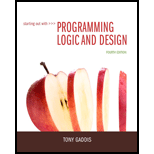
Concept explainers
A ______ controlled loop uses a true/false condition to control the number of times that it repeats.
- a. Boolean
- b. condition
- c. decision
- d. count
The “while” loop is a condition controlled loop, it controls the number of times that repeats.
Hence, the correct answer is option “B”.
Explanation of Solution
Condition controlled loop:
This is a loop which exhibits true or false condition to control the number of times that the loop repeats. For example: “while” loop is a condition controlled loop.
- The “while” loop first checks its expression and then, the statements inside the loop gets executed. It is also called as pretest loops.
- The loop gets terminated when the condition becomes false.
Syntax:
Syntax for the “while” loop is as follows:
while boolean_expression:
# while suite
Example Program:
Consider the following example of condition controlled loop:
#initialization of variable
a=1
#execute the while loop until a is less than or equal to 5
while a<=5:
#Print the value of a
print(a)
#Increment a by 1 for each iteration of loop
a+=1
Explanation:
In the above code, the “while” loop executes until the value of “a” is less than or equal to 5 and then it exits from the program when the condition inside the loop gets failed.
Explanation of incorrect options:
Boolean:
Boolean is not a loop instead it is a data type which is represented with two values either true or false. This value is based upon the flow of the action performed by the program.
Hence, the option “A” is wrong.
Decision:
A decision is not a loop and it decides the case to be executed based upon the situation.
Hence, the option “C” is wrong.
Count:
This is a loop which repeats specific number of times and it keeps track of the counter variable to keeps track about the number of times that the loop executes. For example: “for” loop is a counter controlled loop.
Hence, the option “D” is wrong.
1
2
3
4
5
Want to see more full solutions like this?
Chapter 5 Solutions
Starting Out with Programming Logic and Design (4th Edition)
Additional Engineering Textbook Solutions
Database Concepts (8th Edition)
Management Information Systems: Managing The Digital Firm (16th Edition)
Starting Out with Java: From Control Structures through Objects (7th Edition) (What's New in Computer Science)
Modern Database Management
Web Development and Design Foundations with HTML5 (8th Edition)
Electric Circuits. (11th Edition)
- Please solve and answer the questions correctly please. Thank you!!arrow_forwardConsidering the TM example of binary sum ( see attached)do the step-by-step of execution for the binary numbers 1101 and 11. Feel free to use the Formal Language Editor Tool to execute it; Write it down the current state of the tape (including the head position) and indicate the current state of the TM at each step.arrow_forwardI need help on inculding additonal code where I can can do the opposite code of MatLab, where the function of t that I enter becomes the result of F(t), in other words, turning the time-domain f(t) into the frequency-domain function F(s):arrow_forward
 EBK JAVA PROGRAMMINGComputer ScienceISBN:9781337671385Author:FARRELLPublisher:CENGAGE LEARNING - CONSIGNMENT
EBK JAVA PROGRAMMINGComputer ScienceISBN:9781337671385Author:FARRELLPublisher:CENGAGE LEARNING - CONSIGNMENT Microsoft Visual C#Computer ScienceISBN:9781337102100Author:Joyce, Farrell.Publisher:Cengage Learning,Programming Logic & Design ComprehensiveComputer ScienceISBN:9781337669405Author:FARRELLPublisher:Cengage
Microsoft Visual C#Computer ScienceISBN:9781337102100Author:Joyce, Farrell.Publisher:Cengage Learning,Programming Logic & Design ComprehensiveComputer ScienceISBN:9781337669405Author:FARRELLPublisher:Cengage C++ for Engineers and ScientistsComputer ScienceISBN:9781133187844Author:Bronson, Gary J.Publisher:Course Technology Ptr
C++ for Engineers and ScientistsComputer ScienceISBN:9781133187844Author:Bronson, Gary J.Publisher:Course Technology Ptr C++ Programming: From Problem Analysis to Program...Computer ScienceISBN:9781337102087Author:D. S. MalikPublisher:Cengage Learning
C++ Programming: From Problem Analysis to Program...Computer ScienceISBN:9781337102087Author:D. S. MalikPublisher:Cengage Learning Programming with Microsoft Visual Basic 2017Computer ScienceISBN:9781337102124Author:Diane ZakPublisher:Cengage Learning
Programming with Microsoft Visual Basic 2017Computer ScienceISBN:9781337102124Author:Diane ZakPublisher:Cengage Learning





